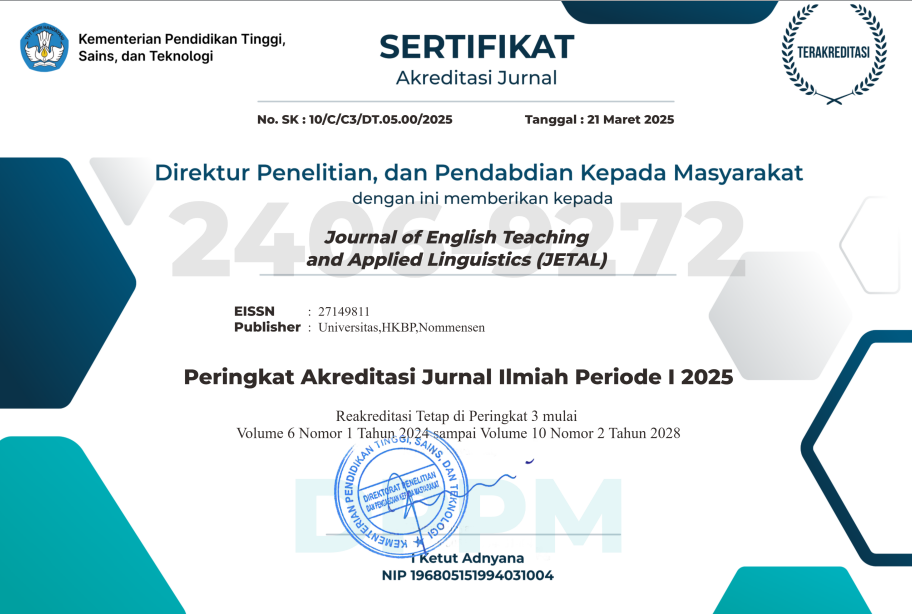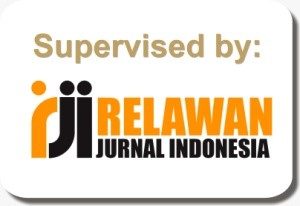An Analysis of Lexical Cohesion on the Students’ Writing
Writing; Cohesion; Lexical cohesion; Narrative text
Abstract
This research aims at finding lexical cohesion in high and low-graded lexical cohesion types on the students' narrative writing. The researcher wants to reveal the reasons why the writing problems exist in lexical cohesion and also to find out what way that the students will use to solve the lexical types in writing narrative text. The present research uses the types of lexical cohesion as proposed by Halliday and Matthiensen (2014). The lexical cohesion items consist of repetition, synonymy, antonymy, hyponymy, and meronymy. The data of this research are derived from students' writing through writing research papers. This research was conducted in qualitative. The results show that repetition becomes the highest occurrence in the students' writing as there are 240 occurrences (64%) in total types of lexical. Nevertheless, the least kind of lexical cohesion is hyponymy. There are only 20 occurrences (6, 6%). It can be seen that the meaning relation in the text occurs among the six types of lexical cohesion to make cohesive text. Besides that, the context of the text itself also refers to coherent text. It means that the text should consist of interrelated sentences to achieve good unity. Both are related to each other in creating well-structured text. The students were sometimes difficult to connect one word with other words. There might be a reluctance of translating the classification of the real words of EFL. Pedagogically, the students need to get studying vocabularies professionally to upgrade the stage of English into an advanced level especially in teaching English writing ability. It was recommended to teachers or lecturers to take an in-depth look at the EFL learners' problems in writing English more than and the English lecturers practice the prompt way to master vocabulary as the core of enhancing the writing quality
References
Creswell, W.J (2009) Research Design Qualitative, Quantitative, and Mixed Method Approaches. USA: Sage Publication, Inc.
Dulay, et al.. (1982). Language Two. New York: Oxford University Press.
Farokh, P. (2012). Raising Awareness of collocation in ESL/EFL classroom. Journal of Studies in Education 2(3): 55-74.
Ghasemi, M. (2013). An investigation into the use of cohesive devices in second language writings. Academy Publisher: Theory and Practice in Language Studies, 3(9), 1615-1623
Halliday, M.A.K. and Matthiessen, M.I.M. (2014). Halliday's introduction to functional grammar (4thed). USA: Routledge
Halliday, M.A.K.(1966).Lexis as a Linguistic Level. In Bazell, C. E.,Catford, J. C.,
Harmer, Jeremy. 2004. The Practice of English Language Teaching (4rd Edition).London: Longman Pearson.
Harmer, Jeremy. 2004. How to Teach Writing.London and New York: Longman.
Haswell, R. (1991). Gaining ground in college writing: Tales of development and interpretation. Dallas: Southern Methodist University Press.
Indriani, Etik. 2015. Improving students' writing narrative texts by using the combination of story sequencing cards and round table technique. thesis.States University of Malang: Malang
James, Carl. 1998. Errors in Language Learning and Use: Exploring Error Analysis. London: Longman. Inc.
Johns. M.Ann.(2002). Genre in The Classroom: Multiple Perspective, United States of America: Lawrence Erlbaum Associates.
Kane, Thomas. 2000. Essential Guide to Writing: New York: Oxford University Press
Knapp, Peter, and Watkins, Megan. 2005. Genre, Text, Grammar. Sidney: University of New South Wales
Lewis, M.(1997) Further development in the Lexical Approach, LTP.
Nasser, M. (2014). The Use of Lexical cohesions by Advanced Saudi EFL Learners in The UK and KSA. International Journal of English Linguistics 5(1):32:43.
Nunan, D. (2003). Practical English Language Teaching. Singapore: McGraw-Hill
Pardiyono. 2007. Pasti Bisa. Andi: Yogyakarta.
Raimes, A.(1983). Techniques in Teaching Writing: Teaching Techniques in English as A Second Language.New York: Oxford University Press.
Ridwan. (2007). Skala Pengukuran Variabel-variabel Penelitian. Bandung: Alfabeta.
Saarinen, 2010. Improving Students' skills in writing narrative text through picture series. A Thesis. Sebelas maret university : Surakarta
Tonder, S.L.V 1999. An Analysis of Lexical Cohesion in W.Somerset Maugham's two short stories Mr. Know-Alland the outstation.
Authors retain copyright and grant the journal right of first publication with the work simultaneously licensed under a Creative Commons Attribution-ShareAlike 4.0 International License (CC BY-SA 4.0) that allows others to share the work with an acknowledgment of the work's authorship and initial publication in this journal.
Authors are able to enter into separate, additional contractual arrangements for the non-exclusive distribution of the journal's published version of the work (e.g., post it to an institutional repository or publish it in a book), with an acknowledgment of its initial publication in this journal.
Authors are permitted and encouraged to post their work online (e.g., in institutional repositories or on their website) prior to and during the submission process, as it can lead to productive exchanges, as well as earlier and greater citation of published work (See The Effect of Open Access).






